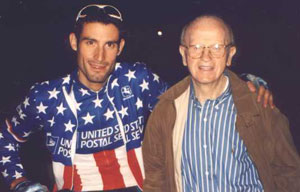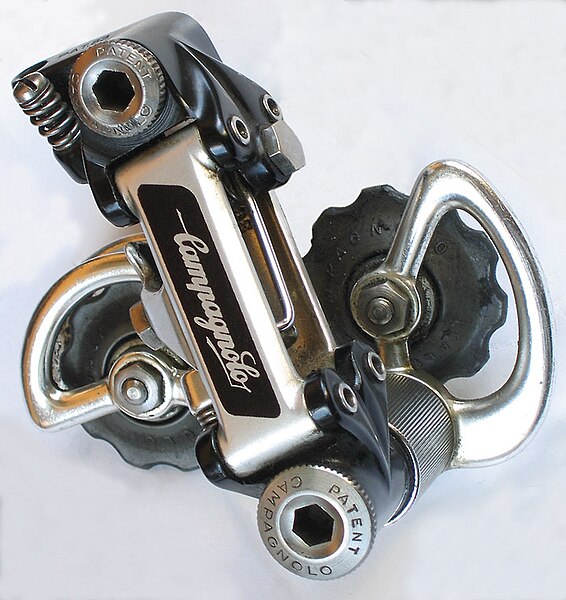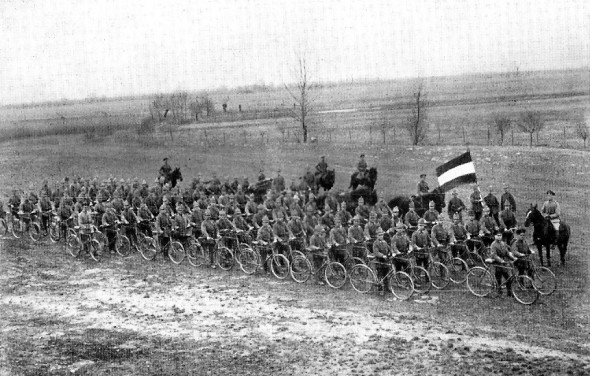The name looked familiar.
Someone shoved him to the ground on East 86th Street, just steps away from Gracie Mansion, the New York City Mayor's residence.
The attacker fled and hopped into a taxi. The man suffered a broken arm and cut to his forehead. A week later, he's in a wheelchair, still recuperating.
The man--91 years old--had gone out around 7 am last Wednesday morning to pick up a newspaper. His attacker was, according to the police, intoxicated and "muttering gibberish" before pushing the man.
Just yesterday the man's name was released: Fred Mengoni. If you race, or have followed racing in the US, you have heard his name: He has done more than almost anyone to bring respectability, and even prestige, to American bicycle racing.
Born in the Italian Adriatic seacoast town of Alcona, Mengoni dreamed of riding in the Giro d'Italia. He adopted what he later described as a "killer" training regimen. Still, he came to the conclusion that he simply didn't have the talent to become a professional cyclist.
In 1957, he emigrated to the US with $50 in his pocket. After a series of ups and downs, he invested in some run-down brownstones in then-unfashionable neighborhoods. It paid off, leading to a prosperous real estate career.
But he never forgot his love of cycling. Nearly every day, he trained in Central Park. In 1980, he started GS Mengoni, which became one of the great teams in US bicycle racing. Among the team's "alumni" are Steve Bauer, George Hincapie and Mike Mc Carthy. He also became an adviser to a young rider named Greg LeMond, with whom he has had a longtime friendship.
.
He also was instrumental in developing USPRO, which he served as president for several years before the US Cycling Federation purchased it and turned it into USA PRO. And he holds the Mengoni Grand Prix in Central Park every year.
Let's all wish Fred Mengoni a full recovery and many more years!
Someone shoved him to the ground on East 86th Street, just steps away from Gracie Mansion, the New York City Mayor's residence.
The attacker fled and hopped into a taxi. The man suffered a broken arm and cut to his forehead. A week later, he's in a wheelchair, still recuperating.
The man--91 years old--had gone out around 7 am last Wednesday morning to pick up a newspaper. His attacker was, according to the police, intoxicated and "muttering gibberish" before pushing the man.
Just yesterday the man's name was released: Fred Mengoni. If you race, or have followed racing in the US, you have heard his name: He has done more than almost anyone to bring respectability, and even prestige, to American bicycle racing.
Born in the Italian Adriatic seacoast town of Alcona, Mengoni dreamed of riding in the Giro d'Italia. He adopted what he later described as a "killer" training regimen. Still, he came to the conclusion that he simply didn't have the talent to become a professional cyclist.
In 1957, he emigrated to the US with $50 in his pocket. After a series of ups and downs, he invested in some run-down brownstones in then-unfashionable neighborhoods. It paid off, leading to a prosperous real estate career.
But he never forgot his love of cycling. Nearly every day, he trained in Central Park. In 1980, he started GS Mengoni, which became one of the great teams in US bicycle racing. Among the team's "alumni" are Steve Bauer, George Hincapie and Mike Mc Carthy. He also became an adviser to a young rider named Greg LeMond, with whom he has had a longtime friendship.
.
 |
| Fred Mengoni with George Hincapie. Photo from A View From The Back |
He also was instrumental in developing USPRO, which he served as president for several years before the US Cycling Federation purchased it and turned it into USA PRO. And he holds the Mengoni Grand Prix in Central Park every year.
Let's all wish Fred Mengoni a full recovery and many more years!


